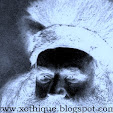About Me

- Jonathan
- Adalbert is a forum for me, to post ephemera, photography, poetry, occasional travel notes, and various spontaneous motions. Cover photo: Parsonage where my great-grandfather spent his early years. Taken near Liegnitz, Silesia, ca. 1870. The "xothique" portion of the web address is a nod to Clark Ashton Smith's fictional continent of Zothique.
Saturday, June 29, 2013
Watching Jeremy Brett
The last year or so I have been watching many of the episodes of the various Jeremy Brett Sherlock Holmes series -- Adventures, Return, Memoirs, Case-Book, made by Granada Television in the 1980s and 1990s. I had originally seen a few episodes in the 1980s but missed a large number of others. With an episode such as the adaptation of The Final Problem, for example, we see the advantages of the Brett-starring series. With Brett, the doubled man -- both bipolar and bisexual (per Wikipedia: http://en.wikipedia.org/wiki/Jeremy_Brett ) -- Holmes was rendered with depth and faithfulness. His face mutable as an Alpine sky, a tic-like smile or angered frown appearing and fading in an instant, his abruptness and eccentricities, Brett was the ultimate portrayer of the detective. With such adaptations as The Final Problem shot on location, with generous footage of the Alps, the soundtrack seasoned with cowbells and other local touches, the real life approach to production shows its superiority to today's fast editing and crappy CGI effects. While some of the 1990s productions sank in quality, with shows such as The Last Vampyre showing an ailing, barely moving Brett, the series at its best had a peerless blend of acting and restrained period detail.
Friday, June 28, 2013
S.M.S. Falke
More than one ship floated under this name -- its predecessor played a part in the Franco-Prussian War.
Thursday, June 27, 2013
Saturday, June 22, 2013
Henderson Studio, St. Paul
Posted by
Jonathan
at
10:49 AM
No comments:

 Labels:
antique photographs,
old photographs,
vintage photographs
Labels:
antique photographs,
old photographs,
vintage photographs
Friday, June 21, 2013
Thursday, June 20, 2013
Bäume
Painting: Bäume, 1986
Acclivity
Bracken and colourless grasses nod in the precipice, always dark and upward, not struck by the sun. The past, and arched bridge over the gulph of river shade, black fishes, and granite. Only the half-apprehension of lightless bulk or upper land.
Musky imminence, the wood outside window and door, moth and coal oil. Unaccountable stains of the whitened moon: straw ridges and imperial alder.
Brow of boulder or hemlock, apparent on top of walls of boughs susurrus -- standing in places just like that. Steeping ruddiness and a sadness, clumped and lit grasses, from the narrow ledge. Wasted and snapped trees. Palaeogean skirting, busy air of huckleberry and toadstool, dipping way of the road over.
An one blanched and shivered tree-crown, appearing through a gap in the rocks, height of hawk and golden bee.
A great staircase made in the summit, the summer-house no longer about, movement of clouds building and lifting down the mountain in the removed, brink, moss-shoared pond: ovine and clotted rocks.
JF ca. 1990
Friday, June 14, 2013
Thursday, June 13, 2013
Monday, June 10, 2013
Halfdan Egedius, meet Eanger Irving Couse
On 8 June 2013 I visited Maryhill Museum in Washington State and the nearby Stonehenge replica:
http://en.wikipedia.org/wiki/Maryhill_Stonehenge.
Posted by
Jonathan
at
8:59 AM
4 comments:

 Labels:
Maryhill Museum,
Sam Hill,
Stonehenge,
Washington State
Labels:
Maryhill Museum,
Sam Hill,
Stonehenge,
Washington State
Friday, June 7, 2013
Jens Bjerre's The Last Cannibals
"I never met a Dane who wasn't bone-dull." Thus wrote William S. Burroughs in The Yage Letters. In spite of Burroughs' statement, I've got at least one exciting Dane to present (there may be one or two in Christiania as well): Jens Bjerre.
In these days I reread a translation by Estrid Bannister of The Last Cannibals (originally published in 1956; this paperback edition from 1958) by Jens Bjerre: http://en.wikipedia.org/wiki/Jens_Bjerre_(adventurer). I don't recall where I procured this copy, probably at a flea market. I once saw Mr. Bjerre himself, in the early 1980s in Portland, Oregon, give a lecture on his travels in Tibet. I remember little about the talk other than he showed some film or photographs of Tibet, the Potala, and so on, as part of the evening. I also recall the fact that he used a gentle humor at times in his comments.For the price of the ticket, one gets descriptions, in The Last Cannibals, of journeys not only in New Guinea:
http://en.wikipedia.org/wiki/New_Guinea, but also an extended stay with Australia Aborigines: http://www.apex.net.au/~mhumphry/aborigin.html. The sequence in Australia, with an immersion in aboriginal life and an intensely evocative description of Ayers Rock, for instance, is as good as the New Guinea sections. In spite of the book's title and the lurid promise of the front and back covers, Bjerre only makes a few incidental references to some New Guinean tribesmen still practicing cannibalism in the 1950s. You don't get baked, barbequed, or boiled long pig, one of the original free range, cage free, local foods, or any eyewitness reports of anthropophagy, in the travel book. You do get a glimpse of smoked corpses of deceased relatives in huts, of malarial lowlands and misty jagged mountains, of origin myths and the aftereffects of World War II in the island, among other things. The book trails off at the end with a fever dream out of De Quincey.
Posted by
Jonathan
at
11:27 AM
9 comments:

 Labels:
Australia,
books,
cannibalism,
New Guinea,
travel
Labels:
Australia,
books,
cannibalism,
New Guinea,
travel
Subscribe to:
Posts (Atom)

















